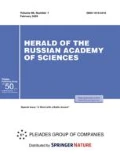Abstract
Over the past few decades, quantitative methods of evaluating scientific work, including the citation index of research publications, have been finding expanding applications. The citation index underlies not only the evaluation of the efficiency of individual scientists but also the rating of scientific editions. The authors share their experience in bibliometric research based on the data of the science and technology network STN International.
Similar content being viewed by others
References
W. Hellemans and B. Bunch, Timetables of Science (Simon and Schuster, New York, 1988), p. 146.
I. Wormell, “Databases As Analytical Tools,” in Encyclopedia of Library and Information Science (Marcel Dekker, New York, 2000), Vol. 70, Suppl. 33, pp. 77–92.
Yu. V. Granovskii, L. V. Duzhenko, T. N. Lyubimova, et al., Scientometric Studies in Chemistry (Mosk. Gos. Univ., Moscow, 1974), pp. 67–79.
Yu. V. Granovskii, Scientometric Analysis of Information Flows in Chemistry (Nauka, Moscow, 1980), pp. 39–47 [in Russian].
H. P. Moed, T. N. Van Leeuwen, and J. Reedijk, “A Critical Analysis of the Journal Impact Factors of Angewandte Chemie and the Journal of the American Chemical Society Inaccuracies in Published Impact Factors Based on Overall Citations Only,” Scientometrics 37, 105–116 (1996).
A. Schubert, “The Portrait of a Journal as Reflected in Its Publications, References, and Citations: Inorganica Chimica Acta, 1990–1994,” Inorg. Chim. Acta 253, 111–118 (1996).
J. Michl, J. A. Gladysz, and R. D. Kuchta, “Over Four Hundred Million Characters Served: 99 Volumes, 2567 Articles, 85 623 Pages, and More Than 85 Million Words,” Chem. Rev. 100, 1–6 (2000).
W. Marx, “Angewandte Chemie in Light of the Science Citation Index,” Angew. Chem., Int. Ed. Engl. 40, 139–143 (2001).
W. Marx and M. Cardona, “The Impact of Solid State Communications in View of the ISI Citation Data,” Solid State Commun. 127, 323–336 (2003).
V. M. Buznik, I. V. Zibareva, V. N. Piottukh-Peletskii, and N. I. Sorokin, “Bibliometric Analysis of the Journal of Structural Chemistry,” Zh. Strukt. Khim. 45, 1142 (2004) [J. Struct. Chem. 45, 1096 (2004)].
I. V. Zibareva and B. G. Derendyaev, “Chemistry for a Sustainable Development: A Bibliometric Portrait,” Khim. Interes. Ustoichiv. Razv., No. 1, 121–128 (2004).
V. M. Buznik and I. V. Zibareva, “Bibliometric Analysis of the Journal Khimicheskaya tekhnologiya,” Khim. Tekhnol., No. 4, 40–45 (2006).
W. W. Hood and C. S. Wilson, “Informetric Studies Using Databases: Opportunities and Challenges,” Scientometrics 58, 587–608 (2003).
K. M. Whitley, “Analysis of Scifinder Scholar and Web of Science Citation Searches,” J. Am. Soc. Inform. Sci. Technol. 53, 1210–1215 (2002).
STN International. URL: http://www.stn-international.de.
A. I. Yablonskii, Models and Methods of Science Study (Editorial URSS, Moscow, 2001) [in Russian].
I. V. Zibareva and N. V. Krukovskaya, “Experience of Using Bibliographic Databases for Scientometric Studies of Russian Chemical Science,” Educational Technologies and Society 10, 297–303 (2007). URL: http://ifets.ieee.org/russian/depository/v10_i1/pdf/30.pdf.
CA Database Summary Sheet. URL: http://www.stninternational.de/stndatabases/sum_sheet/CA.pdf.
SciSearch Database Summary Sheet. URL: http://www.cas.org/ONLINE/DBSS/scisearchss.html.
I. V. Zibareva, T. N. Teplova, and O. M. Nefedov, “Bibliometric Analysis of the Journal Uspekhi Khimii (Russian Chemical Reviews),” Usp. Khim. 76, 747–751 (2007) [Russ. Chem. Rev. 76 (8), 693–698 (2007).
A. J. Lotka, “The Frequency Distribution of Scientific Productivity,” J. Washington Acad. Sci. 16, 317–323 (1926).
D. B. Baker, J. W. Horiszny, and W. V. Metanonski, “History of Abstracting at Chemical Abstracts Service,” J. Chem. Inf. Comput. Sci. 20, 193–201 (1980).
G. K. Zipf, Human Behavior and the Principle of Least Effort (Addison-Wesley, Cambridge, 1949).
Journal Rankings in Chemistry: Essential Science Indicators. URL: http://portal.isiknowledge.com/portal.cgi?DestApp=ESI&Func=Frame
S. C. Bradford, “Sources of Information on Specific Subjects,” Engineering 137, 85–86 (1934).
G. S. Cline, “Application of Bradford’s Law to Citation Data,” College Res. Libr. 42, 53–61 (1981).
S. R. Stevens, “Mapping the Literature of Cytotechnology,” Bull. Med. Lib. Assoc. 88, 172–177 (2000).
A. Tonta and U. Al, “Scatter and Obsolescence of Journals Cited in Theses and Dissertations of Librarianship,” Lib. Inform. Sci. Res. 28, 281–296 (2006).
B. C. Brookes, “Bradford’s Law and the Bibliography of Science,” Nature 224, 953–956 (1969).
O. V. Groos, “Bradford’s Law and Keenan-Atherton Data,” Am. Doc. 18, 46 (1967).
P. Praunlich and M. Kroll, “Bradford’s Distribution: A New Formulation,” J. Am. Soc. Inform. Sci. 29, 51–55 (1978).
JCR on CD-ROM, Science Edition.
P. O. Seglen, “Why the Impact Factor of Journals Should Not Be Used for Evaluating Research,” Brit. Med. J. 314, 498–502 (1997).
Additional information
Original Russian Text © I.V. Zibareva, V.V. Pislyakov, T.N. Teplova, O.M. Nefedov, 2008, published in Vestnik Rossiiskoi Akademii Nauk, 2008, Vol. 78, No. 6, pp. 490–499.
Inna Vladimirovna Zibareva is head of the STN center at the Vorozhtsov Institute of Organic Chemistry, Novosibirsk, RAS Siberian Branch. Vladimir Vladimirovich Pislyakov is a deputy director of the library for control over electronic resources at the State University-Higher School of Economics. Tat’yana Nikolaevna Teplova is managing editor of the journal Uspekhi Khimii (Russian Chemical Reviews). Academician Oleg Matveevich Nefedov is an RAS adviser and editor-in-chief of the journal Uspekhi Khimii (Russian Chemical Reviews).
Rights and permissions
About this article
Cite this article
Zibareva, I.V., Pislyakov, V.V., Teplova, T.N. et al. Bibliometric analysis of the journal Uspekhi Khimii (Russian Chemical Reviews). Her. Russ. Acad. Sci. 78, 247–256 (2008). https://doi.org/10.1134/S101933160803012X
Published:
Issue Date:
DOI: https://doi.org/10.1134/S101933160803012X




